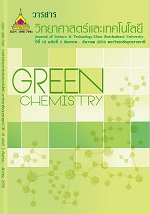ผลของอัตราส่วนยางครัมบ์และแคลเซียมคาร์บอเนตต่อสมบัติเชิงกลและ ทางความร้อนของยางผสมระหว่างยางเอทิลีนโพรพิลีนไดอีนและ ยางธรรมชาติอิพอกไซด์
Main Article Content
บทคัดย่อ
Effect of Crumb Rubber/Calcium Carbonate Ratio on Mechanical and Thermal Properties of Ethylene-Propylene Diene Rubber/Epoxidized Natural Rubber Blends
The aim of this work was to investigate the mechanical properties of ethylene propylene diene rubber and epoxidized natural rubber blends (70/30 EPDM/ENR) filled with hybrid fillers of crumb rubber and calcium carbonate (CaCO3). The crumb rubber/CaCO3 ratios were varied from 0/60 to 60/0 by weight, while the total loading of fillers was kept constant at 60 parts per hundred parts of rubber (phr). The results showed that Mooney viscosity, hardness, and compression set of the blends increased when the amount of crumb rubber was partially substituted with CaCO3, while tensile strength and thermal aging resistance decreased with increasing crumb rubber content in hybrid fillers. It was also found that tear resistance can be improved by incorporating 10-30 phr of crumb rubber into the blends. Namely, the blends containing a crumb rubber/CaCO3 ratio of 30/30 yielded the highest tear strength. However, the decomposition temperatures of EPDM/ENR blends determined by Thermo gravimetric analysis (TGA) were not significantly affected by changing the crumb rubber/CaCO3 ratios. Therefore, it can be concluded that the suitable crumb rubber loadings in 70/30 EPDM/ENR blends having hybrid fillers are in the range of 10-30 phr to realize the deterioration of their mechanical properties and to reduce production costs.
Article Details
บทความที่ได้รับการตีพิมพ์เป็นลิขสิทธิ์ของ วารสารวิทยาศาสตร์และเทคโนโลยี มหาวิทยาลัยอุบลราชธานี
ข้อความที่ปรากฏในบทความแต่ละเรื่องในวารสารวิชาการเล่มนี้เป็นความคิดเห็นส่วนตัวของผู้เขียนแต่ละท่านไม่เกี่ยวข้องกับมหาวิทยาลัยอุบลราชธานี และคณาจารย์ท่านอื่นๆในมหาวิทยาลัยฯ แต่อย่างใด ความรับผิดชอบองค์ประกอบทั้งหมดของบทความแต่ละเรื่องเป็นของผู้เขียนแต่ละท่าน หากมีความผิดพลาดใดๆ ผู้เขียนแต่ละท่านจะรับผิดชอบบทความของตนเองแต่ผู้เดียว


